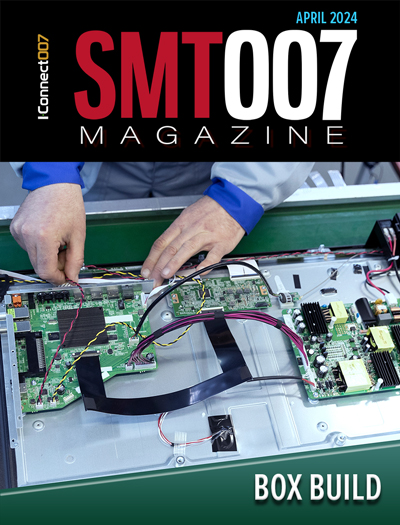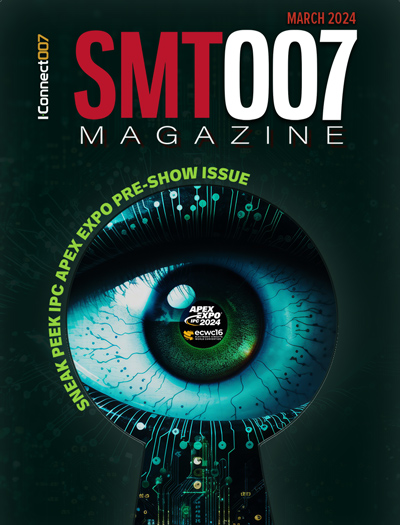-

- News
- Books
Featured Books
- smt007 Magazine
Latest Issues
Current Issue
Box Build
One trend is to add box build and final assembly to your product offering. In this issue, we explore the opportunities and risks of adding system assembly to your service portfolio.

IPC APEX EXPO 2024 Pre-show
This month’s issue devotes its pages to a comprehensive preview of the IPC APEX EXPO 2024 event. Whether your role is technical or business, if you're new-to-the-industry or seasoned veteran, you'll find value throughout this program.

Boost Your Sales
Every part of your business can be evaluated as a process, including your sales funnel. Optimizing your selling process requires a coordinated effort between marketing and sales. In this issue, industry experts in marketing and sales offer their best advice on how to boost your sales efforts.
- Articles
- Columns
Search Console
- Links
- Events
||| MENU - smt007 Magazine
Solder in PCBA: Can’t Live Without It... or Can We?
February 17, 2020 | Joe Fjelstad, Verdant ElectronicsEstimated reading time: 1 minute
Solder is a marvelous material for joining metal parts together at relatively low temperatures. The first use of solder to join metals (mostly for adornments and some simple tools) came on the heels of the discovery of tin in Britain some 4,000 years ago, according to technology historians. The base metal and later simple alloy’s utility found for it an ever-expanding roll in civilization and industry for items as disparate as joining water piping, sealing automotive radiators, and making stained-glass windows. However, its crowning role for most of the last century has been for joining electrical and electronic elements of electronic products, from simple spliced wires to the most advanced chips and chip packages of the present day.
For most of its historical use in electronics, the solder alloy of choice was tin-lead, either an Sn60/Pb40 alloy or the Sn63/ Pb37 eutectic version of the tin-lead alloy. These two alloys were the workhorses of the industry. They were both well understood in terms of their processing and reliability—that is, until the advent of lead-free, a well-meaning but ill-conceived and poorly executed conversion, forced on the industry by the European Union in 2006.
While the purveyors of prospective lead-free solder solutions asserted that they had everything under control, nothing could have been further from reality. After the rollout of the first high-temperature SAC alloys, the industry quickly found out how vulnerable their production lines and products really were. More than $100 billion has since been spent trying to find the equivalent of the tried, tested, and trusted tin-lead alloys.
One of the most frustrating things about the forced conversion was that the stated reasons for risk to all human health were massively overstated.
To read this entire article, which appeared in the February 2020 issue of SMT007 Magazine, click here.
Suggested Items
AIM Solder’s Dillon Zhu to Present on Ultraminiature Soldering at SMTA China East
04/22/2024 | AIMAIM Solder, a leading global manufacturer of solder assembly materials for the electronics industry, is pleased to announce that Dillon Zhu will present on the topic: Ultraminiature Soldering: Techniques, Technologies, and Standards at SMTA China East. This event is being held at the Shanghai World Expo Exhibition & Convention Center from April 24-25.
AIM to Highlight NC259FPA Ultrafine No Clean Solder Paste at SMTA Wisconsin Expo & Tech Forum
04/18/2024 | AIMAIM Solder, a leading global manufacturer of solder assembly materials for the electronics industry, is pleased to announce its participation in the upcoming SMTA Wisconsin Expo & Tech Forum taking place on May 7 at the Four Points by Sheraton | Milwaukee Airport, in Milwaukee, Wisconsin.
Hentec/RPS Publishes an Essential Guide to Selective Soldering Processing Tech Paper
04/17/2024 | Hentec Industries/RPS AutomationHentec Industries/RPS Automation, a leading manufacturer of selective soldering, lead tinning and solderability test equipment, announces that it has published a technical paper describing the critical process parameters that need to be optimized to ensure optimal results and guarantee the utmost in end-product quality.
Empowering Electronics Assembly: Introducing ALPHA Innolot MXE Alloy
04/16/2024 | MacDermid Alpha Electronics SolutionsIn the rapidly evolving electronics industry, where innovation drives progress, MacDermid Alpha Electronics Solutions is committed to setting a new standard. Today, we are pleased to introduce ALPHA Innolot MXE, a revolutionary alloy meticulously engineered to address the critical needs of enhanced reliability and performance in modern electronic assemblies.
New Book on Low-temperature Soldering Now Available
04/17/2024 | I-Connect007I-Connect007 is pleased to announce that The Printed Circuit Assembler’s Guide to… Low-temperature Soldering, Vol. 2, by subject matter experts at MacDermid Alpha Electronics Solutions, is now available for download.


